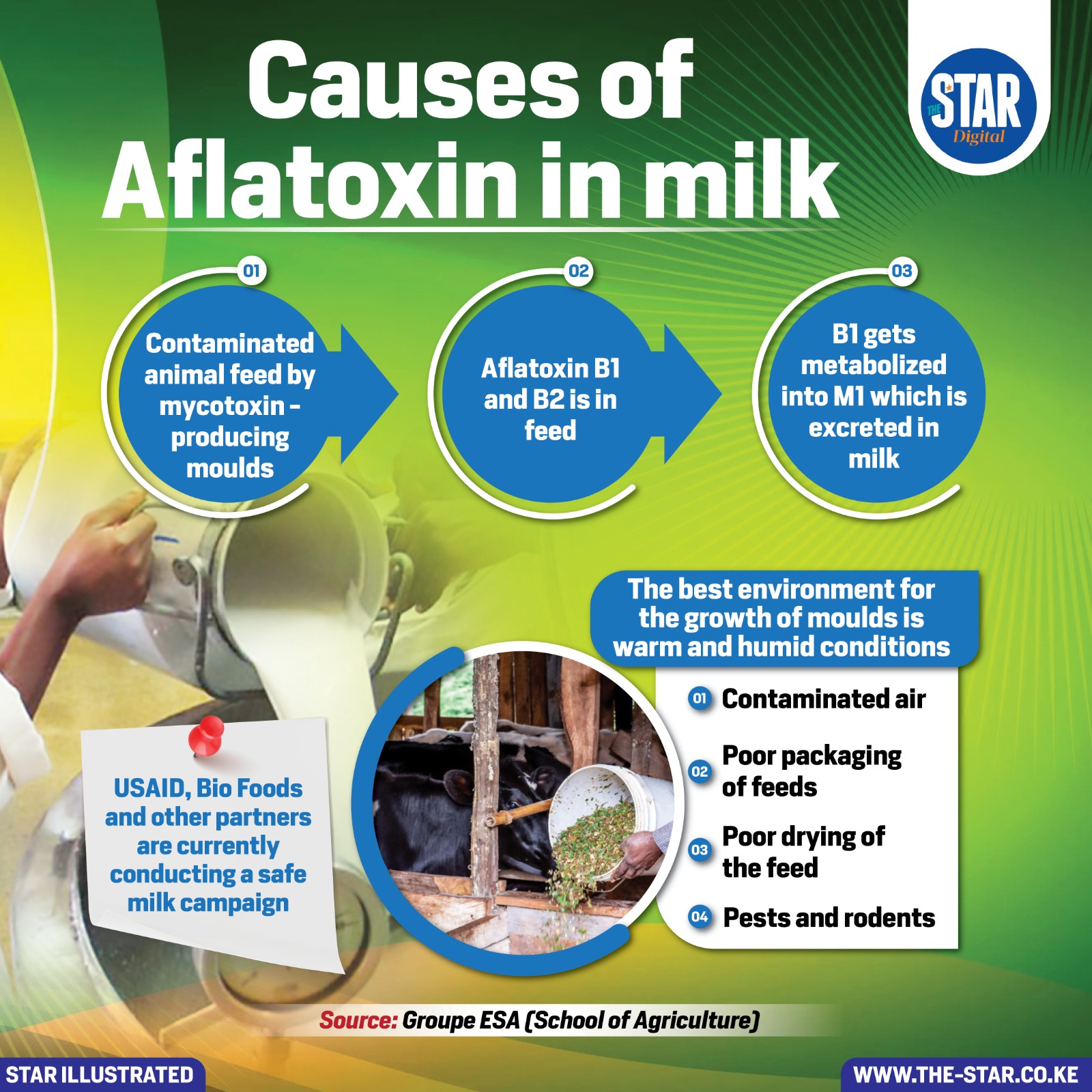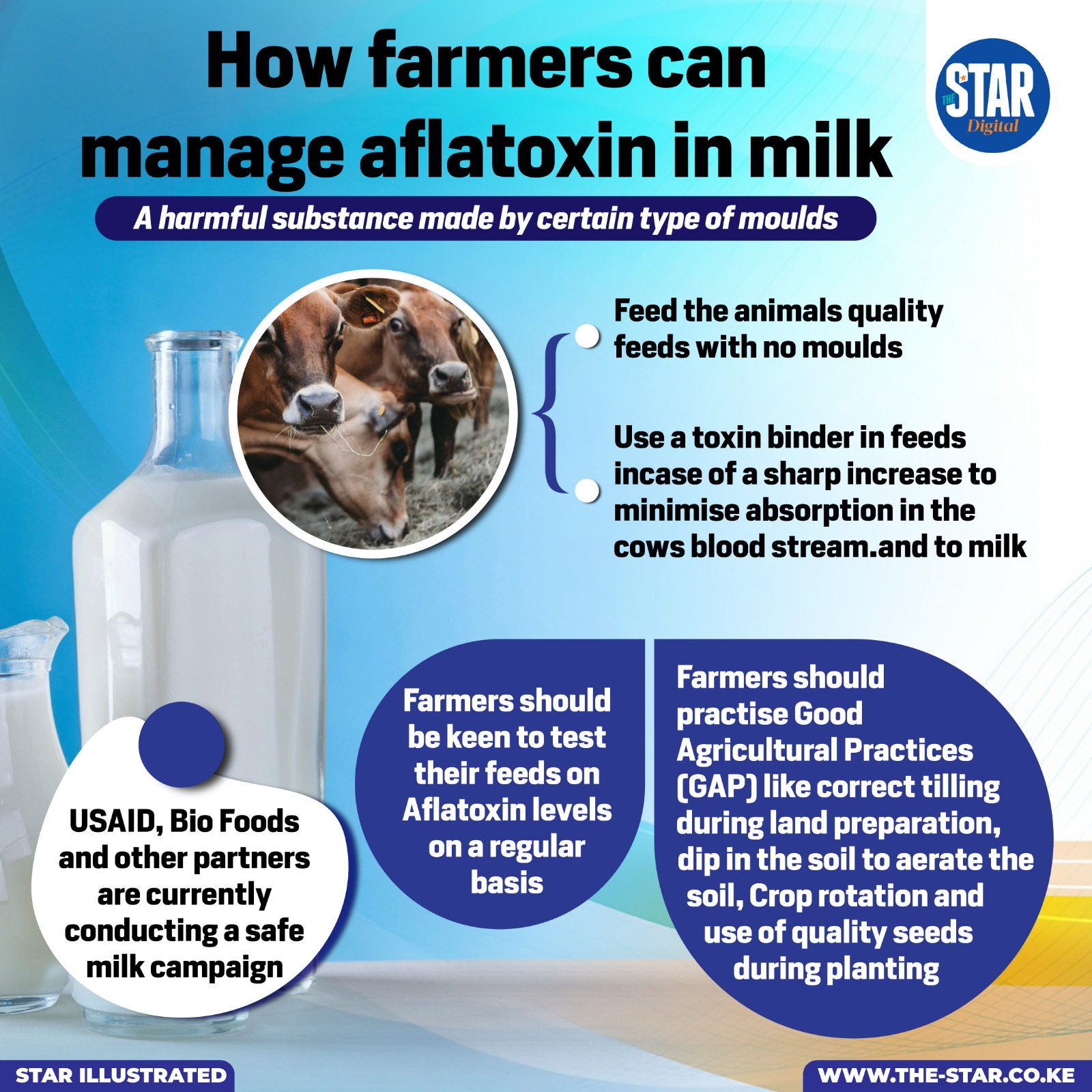
Bio Foods leads drive for quality milk production
The company hosted the Farmers Summit 2024 themed Transforming Kenyan Dairy
Campaign advocates quality feed, proper milking and handling to ensure milk is not contaminated.
In Summary

Audio By Vocalize

The rising sun casts a warm, golden light over the fields in Runyenjes, Embu County. Dedicated dairy farmer Mike Gitonga steps out of his house, ready to milk his seven cows.
As he walks toward the barn, he greets each of his cows by name, a ritual that connects him with his ‘business partners’. He believes a calm and friendly atmosphere is essential for his cows to produce high-quality milk.
Inside the barn, Gitonga carefully checks the cleanliness of the milking area. He scrubs his milking containers clean, ensuring no soap or dirt smell remains to prevent contamination of the milk. Gitonga understands that hygiene plays a crucial role in milk safety.
With this in mind, he also washes his hands thoroughly before starting the milking process. As he milks, Gitonga watches for any signs of discomfort or illness, knowing that healthy cows produce the best milk.
“Milk contamination can occur through improper handling, such as using poorly cleaned plastic cans or milking equipment,” he says. “It’s all about handling the milk properly; the way you handle it will determine its safety for consumption.”
After milking, Gitonga quickly transports his 50 litres of milk to Mutugi Commercial, a nearby dairy cooperative, where it is chilled to the appropriate temperature to inhibit bacterial growth.
“If you don’t have the right preservation equipment, like coolers, the milk can easily be contaminated,” he said, emphasising that milk must be cooled immediately after milking to prevent spoilage. Gitonga also shared the challenges farmers face in ensuring milk safety, particularly the quality of animal feeds. “The quality of the feed is critical,” he said.
“Too much sweet potato vine can degrade milk quality, and certain weeds can spoil the milk. We need to feed our cows clean, well-balanced fodder to ensure the milk remains safe.”

FARMER EDUCATION
Joseph Naimodu, an expert from Olepolos Dairy Cooperative, describes safe milk as milk that is free from contaminants and fit for human consumption.
“Milk is very sensitive. If stored in a dirty container, it will be contaminated and unsafe to drink,” he said.
He urged the government and other stakeholders to find a way to educate farmers on the best practices of handling milk.
“Due to ignorance, some farmers may inject their animals or deworm them and milk them after a few hours,” he said. “This would make the milk have elements of the medicine to be found in the milk and upon consumption, can cause harm to the consumer of that milk.”
He said the society comes from a tradition where people milk cows and consume the milk, not knowing if it is contaminated or not.
“We need to do extensive farmer education to build the knowledge on milk handling and safety of milk,” Naimodu said. Some farmers, when faced with less feeds for their animals, turn to corn rejected for human consumption and mix it with the available animal feeds, he said.
“The rejected corn contains aflatoxins and when animals feed on it, it is transferred to the milk produced, which is in turn consumed by people later on.”
Naimodu said consumers also have a role to play in ensuring what they consume is safe milk.
“Consumers have to push themselves to learn about what they are taking. It is advisable to go for known milk processors whose reputation precedes them,” the veterinary expert said.“
The issue of unsafe milk in our country is a serious trend. It is contributing a lot to the public health of our nation. Most zoonotic diseases and pandemics could be veterinary-related.
“This matter needs to be to be taken seriously, and the government, through the Director of Veterinary Services, needs to have all these issues addressed through working on a one-health programme.”
The expert said there is already a one-health approach, a one-health programme that would bring all the practitioners in the medicine industry together.
“So, when we are one thing, we can have milk checks. We can have checks on the water consumed by people, checks on the milk we consume, all these issues will be addressed.”
Dr Miseda Were, a veterinary surgeon, highlighted the threat of aflatoxins — toxins produced by fungi such as Aspergillus flavus and Aspergillus parasiticus.
These fungi commonly infest animal feeds, especially those made from moist or improperly stored maize, which can lead to the transfer of aflatoxins into the milk.
“Aflatoxins may not make the animals visibly ill, but they pass into the milk, ultimately entering the human food chain,” Dr Were said.
QUALITY FEED
In response to this challenge, Bio Foods and Lato Milk, in partnership with Bles Dairies, officially announced the harvest of more than 220 acres of precision-cut maize silage during a visit to the Fodder Project in Endebess.
This initiative, part of the Kenya Livestock Sector Steering Committee chaired by Livestock PS Jonathan Mueke, aims to reduce milk production costs, particularly during dry seasons, while increasing milk yields by up to 30 per cent.
The project’s vision is to improve milk quality and lower feed costs, ultimately boosting profitability for farmers.
Speaking to the Star, Mueke said boiling milk might reduce some of the bacterial counts but will not get rid of aflatoxin.
“Aflatoxin comes from the animal feed that the cow ate. It causes stunted growth in children. It causes cancer in human beings,” Mueke said.
“So we need to ensure any aflatoxin-laced milk doesn’t even make it to the consumer; it gets discarded at source because once it’s in the milk, there’s no way to get rid of it. So that’s why we do testing with lactometers at the point of purchase.”
The PS said milking equipment is expensive but if the farmer can afford it, by all means they should get it. “We are now also updating our Dairy Bill to ensure we tighten the laws and regulation around milk,” the PS said.
“The Act we have now that governs milk is from 1957. So, we have come up with a Dairy Bill 2024 that is industry-led.”
Bio Foods has made the high-quality maize silage available to farmers and cooperatives at an affordable rate, alongside management support to help farmers maximise its benefits.
This project directly addresses the challenges of safe milk production by ensuring that farmers have access to clean, nutritious and safe fodder for their cows.
The Kenya Dairy Board, led by managing director Margaret Kibogy, commended the project, saying it plays a vital role in achieving long- term growth in the dairy sector.
“As we implement quality-based payment systems and scale capacity for milk testing, we are building a sector that prioritises consumer safety and farmer empowerment,” Kibogy said.
As part of the Safe Milk campaign, experts stress the importance of providing cows with clean, safe fodder and silage to combat aflatoxins and ensure the safety of milk.
The precision-cut maize silage offered by Bio Foods and Lato Milk, as part of this new fodder project, is an example of how farmers can improve the quality of their feed and, in turn, the safety of their milk. Bio Foods CEO Joachim Wester-veld said transforming Kenyan dairy is about more than just increasing production.
“It’s about creating a sustainable ecosystem where farmers thrive, consumers enjoy quality products and the environment is protected,” he said.
This vision aligns perfectly with the goals of the Safe Milk campaign, which advocates a holistic approach to milk safety.
This entails starting with high-quality, toxin-free feed, moving through proper milking and handling procedures, and ultimately ensuring safe, contaminant-free milk for consumers.
Experts say detecting aflatoxins in milk requires specialised testing, such as using an alcohol gun or laboratory analysis. “If milk is contaminated, it will show signs of fermentation during testing,” Naimodu said.

However, on the farm, rapid tests can help identify contaminated milk before it reaches consumers.
Farmers are encouraged to adopt practices such as using proper milking equipment, maintaining good hygiene and, most importantly, ensuring their cows are fed clean and safe fodder.
By integrating practices that prevent aflatoxin contamination at the farm level, such as providing properly stored, toxin-free silage and other feeds, farmers can ensure that the milk they produce is safe for consumers.
HEALTH RISKS
The Safe Milk campaign promotes awareness about the vital connection between clean fodder, cow health and the quality of milk.
Ensuring that animals are fed clean, safe silage and avoiding the use of contaminated feed is crucial in combating aflatoxins.
By focusing on safe feed storage practices and ensuring cows receive clean, high-quality fodder, the risk of aflatoxins can be significantly reduced.
This is a critical step toward safeguarding milk quality right from the farm. Joseph Naimodu also pointed out that challenges in milk handling and transportation must be addressed to maintain milk quality.
“Milk storage in clean, cool containers is essential, as any delays or improper handling can promote bacterial growth and contamination,” he said.
Additionally, using proper, safe feed for animals is a key measure to prevent contamination with aflatoxins.
Aflatoxins in milk pose serious health risks. When consumed, they can cause severe health issues, including cancer and stunted growth in children, Dr Were said.

To prevent aflatoxin contamination, farmers must be educated on the safe handling of milk and the importance of clean, well-maintained feeding practices.
“Farmers must know the ingredients in the feed they provide to their cows and choose feeds that are safe and free from contaminants,” Dr Were said.
Ensuring that the feeds are properly stored in dry, cool conditions and free from mould will go a long way in preventing aflatoxins from entering the milk supply.
Despite the importance of proper feed management, many farmers face challenges such as high feed costs and a lack of proper milking equipment.
“Using affordable yet safe containers and ensuring proper milking practices is crucial to prevent contamination,” Naimodu said.
Education and support for farmers on safe feed storage, milking equipment and proper handling techniques are key to combating aflatoxins.
The Safe Milk campaign is a critical step to raising awareness about the dangers of aflatoxins in milk and promoting safe practices at the farm level. The new fodder project, supported by Bio Foods, Lato Milk and Bles Dairys, is a key initiative in providing farmers with access to high-quality, affordable silage, which directly contributes to improved milk quality and safety.
By focusing on the quality of fodder, proper feed storage and good hygiene practices, farmers can significantly reduce the risk of aflatoxins in their milk. Ultimately, safe milk starts at the farm and requires concerted efforts from all stakeholders to ensure it reaches the consumer free of con- taminants.

The company hosted the Farmers Summit 2024 themed Transforming Kenyan Dairy